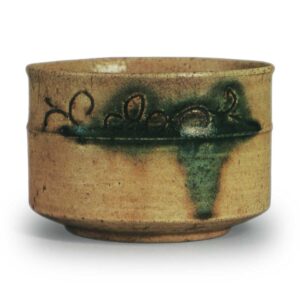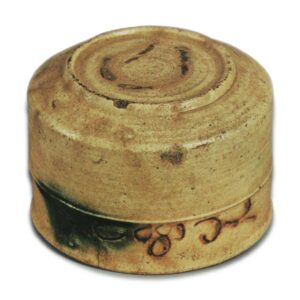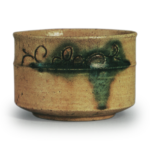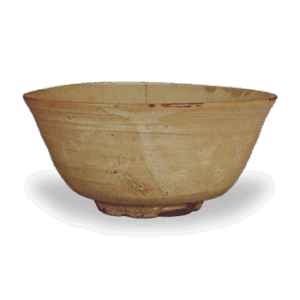

Height: 7.6cm
Diameter: 10.8-11.2cm
Outer diameter of foot ring: 7.5cm
Height of foot ring: 0.4cm
Like the Namba, this type of bowl was originally used as a side dish, but it is also used for tea bowls. The low, wide foot ring is not really suited to tea bowls, and it is more like a small bowl or a side dish.
Also, it is thought that it was not that long ago that they started to be used for tea bowls, but in Toda Rogen’s “Gogaku-shu” (Collected Works of a Scholar of the Later Period), it is written “Kise-do-tsubo, Nijo-aoi, Nijo-kou, Kise-do-no-uchi daiichirui, Motonagata, Ima Mitsui”, and it is thought that they were already being used as tea bowls and highly valued in the early Meiji period, when Rogen was active.
The ridgeline of the body, which rises straight up from the waist, tapers slightly towards the rim, and is slightly convex at the rim, is a characteristic of the early Momoyama period. Another characteristic of this type of Kise-do is the single line of decoration that runs around the middle of the body, and it is also usual for a floral pattern of four petals to be engraved above this line, with arabesque-like engraved lines on either side of the flowers. The single line around the body gives a sense of closure to the otherwise monotonous cylindrical shape, and the decorative effect is also very effective, making it a design that is simple yet to the point, and very characteristic of the Momoyama period.
The high reputation of this tea bowl is due to the vividness of the yellow Seto glaze that covers the entire surface, as well as the beauty of the inro dots on the pattern.
The thickness of the glaze seems to be slightly thinner than that of the Namba, and therefore the yellow Seto glaze is also somewhat lacking in moisture, but what makes up for this is the vividness of the gallstone pattern, especially the gallstone pattern on the surface of the wave, which is something that cannot be seen in the Namba.
The yellow glaze is slightly thicker than the exterior, and the oiled skin, which shows craquelure throughout, is very appealing. The inside of the footring is slightly charred, but this is also a characteristic often seen in this type of yellow Seto ware.
Aside from the Asahina, when it comes to yellow Seto tea bowls, the Namba tea bowl is representative of the west, and the tea bowl in the Hatakeyama Memorial Museum is highly regarded for its dignified workmanship. Both of these were probably made in the Mino Okaya kiln.
The inscription on the box and the lid of the “Kise-do tea bowl” is written by Mitsunosuke Mitsui, as indicated by the “Taizan (signature)” on the underside of the lid, and it is said that it was passed down in the Nagata family, but the Iseki family was a well-known wealthy family in Kyoto.








